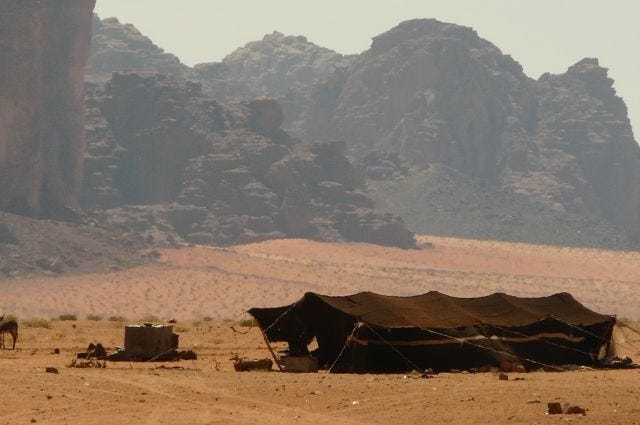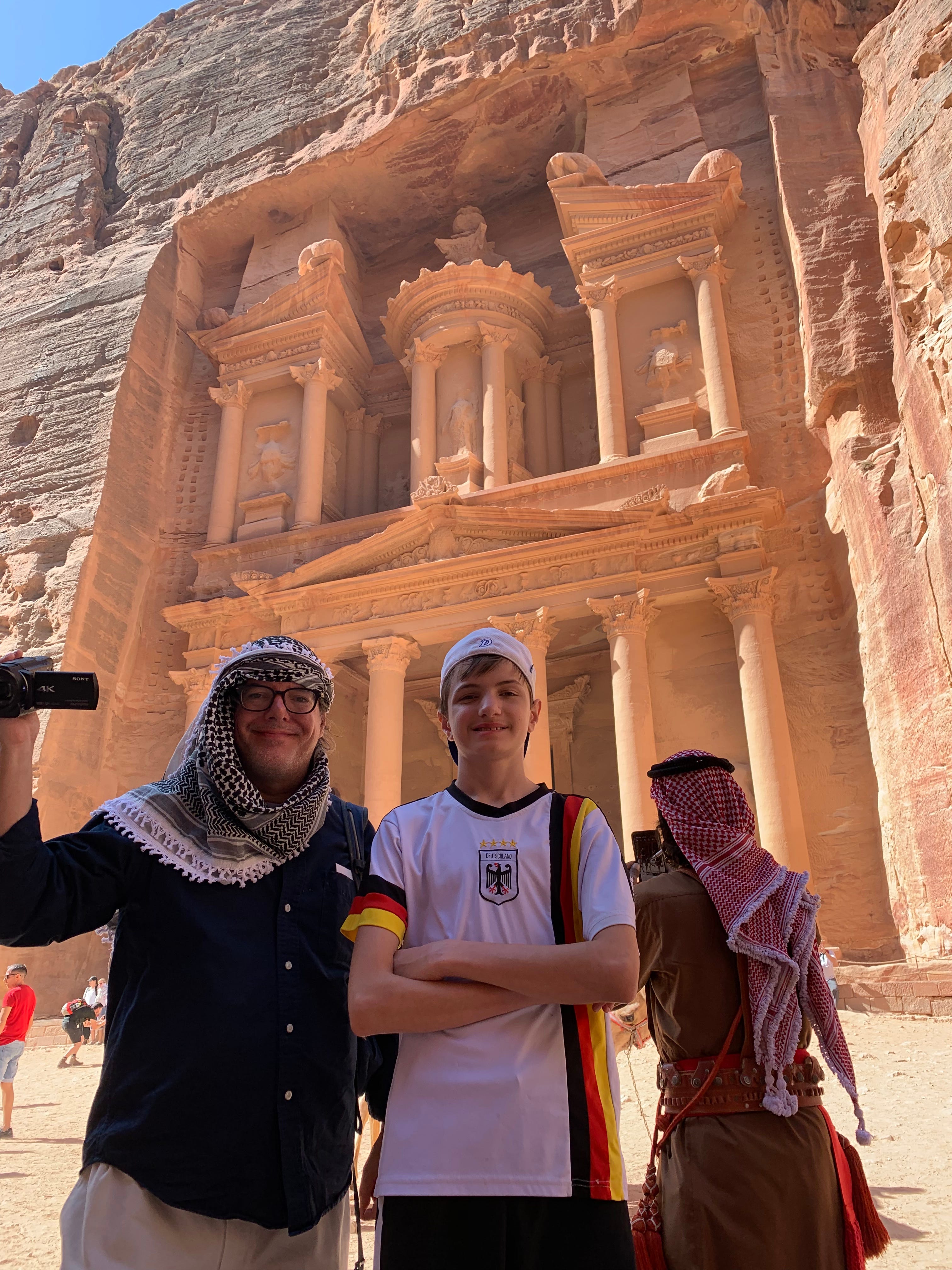By Kent R. Kroeger (NuQum.com, November 18, 2019)
________________________________________________________________
This essay documents my challenges and observations during my family’s recent travels through Oman and Jordan.
This is the third essay in a series. The previous essays can be found here and here.
________________________________________________________________
The last destination in our journey through southern Jordan was Petra, an archaeological city that was the capital for the Nabataean Kingdom from about the 4th century BC until a major earthquake in 363 AD led to its eventual abandonment.
One of the best preserved structures in Petra, Al-Khazneh, also known as “The Treasury,” is its most famous, having served as the fictional resting place of the Holy Grail in Steven Spielberg’s 1989 movie, Indiana Jones and the Last Crusade.

Of all the touristy things we planned, for Zach, visiting “The Treasury” at Petra was the trip’s most anticipated event. The drive would be a couple of hours from Wadi Rum and the views along the way spectacular, according to Abo, our Jordanian guide.
He wasn’t kidding. The Jordan-Arabah Valley near Petra is deep and wide, employing a limited color palette ranging from grey pewter to buttermilk tan, but giving it a grim starkness no less stunning than the Grand Canyon or Bryce Canyon. My son described the Valley and the Edomite Mountains that define its texture as South Dakota’s “Badlands on steroids.”

At one point, Abo pulled the car over so we could take a few photos. To get a cleaner picture without the intrusion of cars, homes or highways, I smuggled myself away from the parking lot as far away as possible (without falling into the Jordan-Arabah Valley). From my vantage point there was no evidence of modern civilization, just the vastness of the Valley and its grey mountains. For a brief moment, I was Christopher Reeve in Somewhere in Time, a motivated time traveler. Moses himself, standing on that same spot, would have seen exactly what I saw on that day.
And, not coincidentally, the tallest mountain in my sight was Jebel Nebi Harun (“Mountain of the Prophet Aaron” in Arabic), one of the holiest sites in Jordan, venerated by Muslims, Christians and Jews as the resting place of Prophet Haroun, Moses’ brother.
________________________________________________________________
But, as spectacular as the scenery was as we resumed our drive to Petra, my attention was drawn to Abo as he told us a story about another entourage he once escorted to Petra on the same highway.
No more than 30 kilometers outside Wadi Musa, the gate city to Petra, we passed a black Bedouin tent, one of many that we had seen in Jordan.

Bedouin tents, called Bait al Sha’er (‘House of Hair’) in Arabic, are made of goat hair, typically black, and are typically divided into two sections separated by a curtain known as a ma’nad. One side is reserved for the men and male guests and is called the mag’ad (‘sitting place’). The other half of the tent, called the maharama (‘place of the women’), is for cooking and female guests.
As we passed this particular Bedouin tent, Abo asked an unexpected question: “Have you heard of Muammar al-Gaddafi?”
In hesitating unison, we all gave a nod, or some indication in the affirmative. Undeniably, I had few positive images of Gaddafi. If we had done a free association exercise, my thoughts regarding Gaddafi would have been: Libyan dictator, Colonel, bombing of a Pan Am flight over Lockerbie (Scotland), gave up Libyan nuclear program, female guards (some taken from their homes as young girls and raped before becoming guards), his execution by rebels during the Libyan Civil War.
I do not have a positive view of Gaddafi…though I do have one quirky remembrance of him: In September 2009, he was scheduled to attend a United Nations General Assembly meeting in New York City. As he often did when he traveled abroad, he took with him a large Bedouin tent that he would set up to receive guests and dignitaries. What I did not know, until Abo told me, was that Gaddafi was born a Bedouin and carried its core tradition of exceptional hospitality with him when he became the Libyan leader in 1969 following a military coup.
In Bedouin culture, said Abo, a family will take in guests — who may be complete strangers — to stay in their home for as long as they need, without question. In fact, the host will not ask any questions of the visitor — even their name — until the fourth day of the stay. [I don’t even let immediate family stay more than three days in my home.]
During Gaddafi’s 2009 visit to New York City, he wanted to set up his tent in Central Park, but objections by the U.S. government stopped that idea. So, instead, somewhat ironically, Gaddafi had to rely on the hospitality of a private American citizen with a soft spot for aggrieved dictators — Donald Trump — to locate a large tract of private land in suburban New York City where the tent could be erected.
That is my Gaddafi memory. Abo had his own.
A little background first.
In October 2000, Gaddafi made his first visit to Jordan since King Abdullah II had been crowned the country’s ruling monarch in 1999.
Gaddafi had a famously icy relationship with other Arab leaders, including Jordan’s King Hussein, King Abdullah’s father. Observers would remark that the only thing Arab leaders ever reached a consensus agreement on was their collective dislike of Gaddafi.
Part of their annoyance with Gaddafi was his uncompromising support of the Palestinian cause and willingness expose Arab leaders when he felt they betrayed the Palestinian people. For that, Gaddafi is still admired by many Palestinians today.
But Gaddafi could sometimes just be rude and, especially when directed towards Arab monarchs not accustomed to such treatment, it caused deep-seeded resentment.
At the 1988 Arab League meeting in Algiers, Algeria, Gaddafi invited the other attending Arab leaders to “go to hell,” and, at one point, pulled a white hood over his head when Jordan’s King Hussein was giving a speech.
Gaddafi was the Kanye West of Arab leaders.

_________________________________________________________________
Abo’s Gaddafi story started as we passed a black Bedouin tent just outside of Wadi Musa. As Abo tells it, Gaddafi’s entourage passed a similar Bedouin tent in this same area back in 2000, on the way to a luncheon with King Abdullah in the ancient city of Petra. However, after spotting the Bedouin tent, Gaddafi had the entourage’s fleet of cars pull over and stop.
“Gaddafi exited his car and asked everyone to place their cellphones in the trunk of one of the cars,” recalled Abo. “Nobody would be able to contact King Abdullah’s staff to notify them of Gaddafi’s likely late arrive to the luncheon.”
The male head of household greeted Gaddafi and invited him for food and coffee, as would be the Bedouin custom.
“Three hours later,” laughed Abo.
Gaddafi was so moved by the hospitality of this Bedouin family he would later send them money to build homes for the parents and their children, according to Abo, who spoke passionately about Gaddafi’s desire to be “with the people, no matter their status.”
Back in Petra, King Abdullah, who waited for Gaddafi’s arrival at the luncheon, was furious. When Gaddafi finally did arrive, King Abdullah let the Libyan leader know how profoundly insulted he was by the tardiness, softening his admonishment somewhat by calling Gaddafi a “mentor.”
As well-know as Gaddafi was for his legendary rudeness, he was equally well-known for his ability to charm enemies and critics (when motivated to do so), and did exactly that with the young Jordanian King.
Years later, King Abdullah would authorize Jordanian special forces to assist in the overthrow of the Gaddafi regime in 2011.
Eventually, we did make it to Petra, and it was spectacular.


– K.R.K.
All comments and questions can be sent to: kroeger98@yahoo.com
